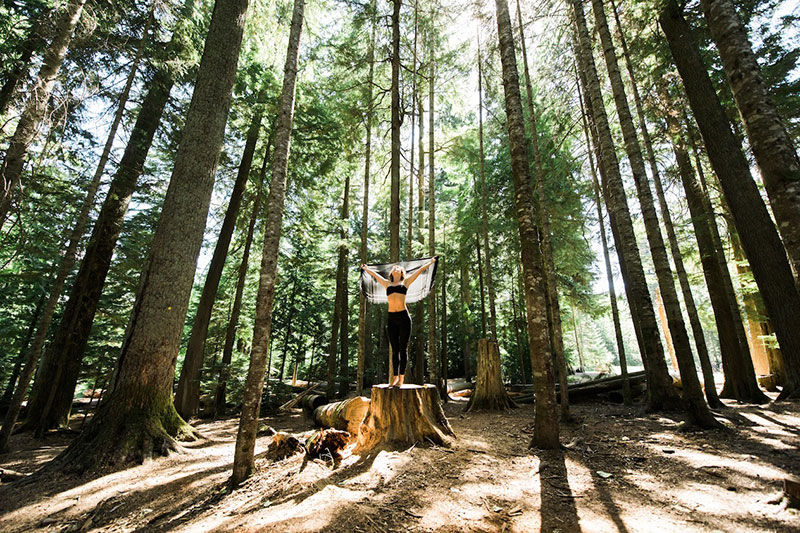By Linda Moon, ND
Shinrin-yoku, or “forest bathing”, is a scientifically validated therapy that is popular in Japan, and now being promoted in Australia.
Imagine that the sounds, sights and aromas of a forest could heal your body, mind and heart. Not the stuff of fairytales, according to Dr Qing Li, associate professor at Nippon Medical School, Tokyo and president of the Japanese Society of Forest Medicine. Li is at the forefront of research on “forest bathing” (shinrin-yoku), a Japanese therapy now being promoted by Healthy Parks Healthy People Central, an Australian initiative aimed at connecting people to nature. The therapy has been scientifically proven to boost immune function and mood and hailed as a legitimate therapy in preventing hypertension, depression, stress and even cancer.
Boost immunity
Since 2005, Li and his research team have studied the effects of walking in forests upon human health. Li found that people who undertook a three day/two night trip to a forest area experienced a significant increase in the activity and number of NK (natural killer) cells – immune cells with a major role in destroying tumours and virally infected cells. In the study, published in Environmental Health and Preventive Medicine, subjects also recorded a rise in intracellular anti-cancer proteins and continued to experience increased NK cell activity 30 days after the trip.
Other studies conducted by Li and his team found that forest bathing reduced blood pressure, blood glucose and the stress hormones cortisol, adrenaline and noradrenaline. Subjects who undertook a day trip to a forest park reported reduced anxiety, depression, anger, fatigue and confusion and an increase in vigour in a Profile of Mood States test. Li says the effects of forest bathing on mood and blood pressure can be attributed to an increase in the activity of the parasympathetic nervous system (responsible for relaxation and renewal) and a decrease in sympathetic nervous system activity (responsible for the fight-or-flight response). Studies also show that ‘green exercise’ has superior health benefits to similar exercise conducted in a man-made environment. For example, Li and his research team have observed reduced blood pressure and increased NK cell activity in forest walkers – but not in control groups who performed the same amount of exercise in urban areas.
Natural healing power
Li believes the therapy works through the five senses, but particularly through the action of inhaled phytoncides – antimicrobial essential oils emitted from plants and trees to protect them from insects, predators, and rot – describing it as “similar to a natural aromatherapy.” The healing effects are freely accessible, and as benefits begin to appear after as little as 40 minutes, simply spending leisurely time in the forest is the only requirement. Feel the breeze against your skin, listen to the murmur of running water or chirping birds, taste and inhale the aromas of foliage, gaze at the trees, and touch the texture of bark and leaves.
Although research has mainly been conducted in Japanese forests, Li believes “any forests should have similar effects.” Forest bathing, a term coined in 1982 by the Japanese Forest Agency, encompasses the broader fields of forest medicine and eco-psychology (nature guided therapy). Li views forest bathing as “a new preventive medicine that will contribute to the reduction of lifestyle related diseases and even reduce health expenditures.”
Some researchers also question the effects of modern urban living from an evolutionary perspective and believe that stress, together with loss of vitality and health, may be a potential outcome of being separated from the natural environment our physiology evolved in. While we’ve always known a walk in the forest makes us feel good, finally science is telling us why.
Maximise your experience
- Choose a forest or park with a good density of trees. For best results, trees should be a minimum of 5 metres tall on land with a tree canopy of over 10 percent and an area greater than 0.5 ha.
- Absorb the forest through your five senses – smell, sight, sound, touch, and taste.
- Avoid exhausting yourself. Rest if you feel tired, drink water or tea if thirsty.
- Take your time. Sit and enjoy the scenery or read a book. The idea is to let the forest work its magic on you.
- If possible, take a spa after the experience.
- For optimum results, a two night/three day forest trip is best.
- For a whole day of forest bathing, stay in the forest about four hours and walk about five kilometres. For half days, stay in the forest about two hours and walk about two and a half kilometres.
Get your forest fix
NSW:
- Blue Mountains National Park, 100km west of Sydney CBD
- Royal National Park, 32km from Sydney CBD – try the 4.5km Forest Path
- Barrington Tops National Park, Hunter region
Victoria:
- Toolangi State Forest, Central Highlands
- Sherbrooke Forest, within the Dandenong Ranges, 40km east of Melbourne
Queensland:
- D’Aguilar National Park, 10-35km northwest of Brisbane
- Springbrook National Park, Gold Coast Hinterland, 96km south of Brisbane
- Daintree rainforest, accessible from Cairns, Port Douglas, Cape Tribulation
Western Australia:
- Ancient Empires Walk at the Valley of the Giants, Rainbow Coast
South Australia:
- Mount Crawford Forest, 1 hour’s drive north of Adelaide
Northern Territory:
- Holmes Jungle Nature Park, 20km from Darwin city
- Howard Springs Nature Park, 35km from Darwin city
Tasmania:
- The Tarkine (Northwest)
- Southwest National Park, 93 km west of Hobart
Linda Moon is a naturopath, massage therapist and partly trained social worker. Her passion is sharing knowledge to inspire others. For more information, visit the International Society of Nature and Forest Medicine: http://infom.org
Read more at http://www.natureandhealth.com.au/news/into-the-green#1ECmOQ4qyJltjrgq.99
By Linda Moon, ND

